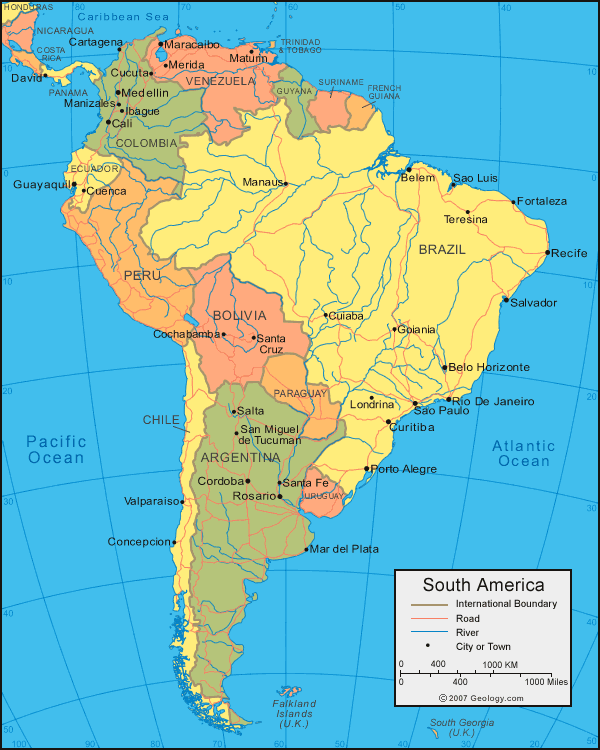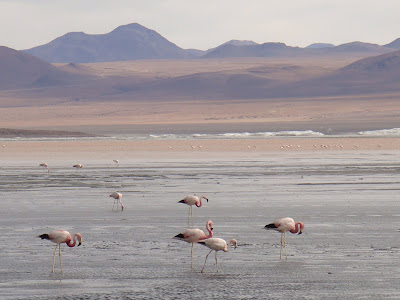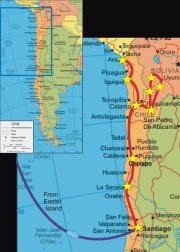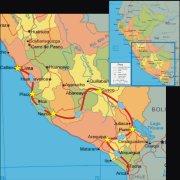The high altitude may lead to impressively blue skies and clear (i.e. thin!) air, but there are a few definite disadvantages to venturing this far above sea level. The most obvious is the risk of Altitude Sickness (or Mountain Sickness) – physiological changes in the body in response to the low oxygen concentration in the air can cause severe problems for some people. Gary and I were both fine with the altitude, especially as we’ve been popping up and down to the Altiplano in Chile and Bolivia for weeks now! But we still felt a bit short changed of air sometimes if we exerted ourselves. It’s a strange feeling to get out of breath when climbing a few steps – makes you feel really unfit! Actually we spent one afternoon climbing up one of the mountains overlooking Puno to a 4000m Mirador (view point), so there were a few hundred steps to make us feel unfit… the spectacular views over the town and lake were worth the effort though!
The second major drawback to the high altitude was the temperature. In the day the strong sun beats down over Puno, leaving you feeling warm – and frizzled if you don’t use enough sun tan lotion! But as soon as the sun drops behind the encircling mountains the air becomes icy. We were visiting in the summer, and within 20 minutes of sun-down the temperature would fall way below zero. The locals respond to these contrasting temperatures very oddly – they seem to wear 20 odd layers of clothing all the time! We found this barmy – they must absolutely roast in the heat of the day, and probably still feel chilly at night as there is one thing they certainly don’t do – heat the buildings. No fires (unless for cooking), no radiators. Basically Puno seems to have no heating of any kind in its buildings. Which leads to some freezing nights shivering under the 5 layers of blankets supplied by the hotels!
Three nights of shivering was enough for us (well, me really – Gary seems impervious to the cold!). But at least as a reward we managed to see a truly remarkable part of the world. Lake Titicaca is vast, with a surface area of more than 8500 square km it is over 15 times the size of lake Geneva in Switzerland. And although the views from the hills around Puno are impressive, most of the main body of the lake lies out of sight around the headlands from here! it is only really possible to appreciate the size of the lake by going on a boat to visit some of the islands. During the hours needed for the small boats to chug across the water it feels like you’re venturing out onto an ocean… well, the distant shores are certainly too far away to see with the naked eye!
We wanted to visit Isla Taquile, a large inhabited island near the centre of Lake Titicaca. Unfortunately the only way to get there without arranging to stay with locals on the island was to go in a boat with a tour group – which meant we had to use our ingenuity to get away from the guide! Actually this wasn’t possible at first as the boat stopped at the Uros floating islands on the way to Taquile. These tiny man-made reed islands literally float on the surface of the lake, anchored in place to form small communities. There are over 50 floating islands, each with its own group of houses and fish farms, and some with schools and communal buildings. The people who live on the Uros islands must spend all of their time rebuilding them - the reeds rot away pretty swiftly. Well, the locals probably devote all of the time they have left after ‘putting on a show for visitors’ to rebuilding islands. Although seeing the floating islands was remarkable, and stepping onto the decidedly squidgy reed-ground was weird, we actually found this part of the trip pretty painful.
Gary and I hate being headed around or lectured to – we like exploring strange places! So if we are forced to use a tour for transport we get away from the group as soon as we can (usually within seconds of leaving the bus) and wander around as usual. But in Uros this was impossible – the reed islands are tiny! As a result we were forced to hear the excruciatingly long lecture of a guide who a) thought far too much of himself, b) had really bad English, and c) talked really slowly, often repeating himself, for a long, long time… Not good! This bloke really liked the sound of his own voice. Eventually he stopped, and then we escaped to wander around the tiny island, and capture nice photos from the roof of the boat. Luckily from here on we were able to escape the package – when the obnoxious guide tried to heard everyone onto a ‘traditional reed boat’ we just refused to move from the roof of the transportation boat (meaning we didn’t have to pay for a ride in a small boat packed with people, and so we got far better views of the floating islands when our transportation boat moved off to pick everyone else up!). And then by staying on the roof of the boat as it moved towards Isla Taquile we avoided the commentary we’d have had to endure inside, and had stunning views of the vast Titicaca Lake. Much better!
Our escape from the evil self satisfied guide continued on Taquile. After the boat docked we made our way up the steep side of the island to the main square of the tiny village (dodging plenty of kids trying to sell braided bracelets en route). Here we swiftly made our escape from the controlling guide who really wasn’t happy about it. He told us to ‘stay near here’ – to which my smiling sarcastic response was ‘No! That would be boring! Much better to explore!’ (I was annoyed with him by this point). He clearly wanted to earn commission by making us spend money in gift shops and restaurants! Instead we spent a lovely few hours walking along an isolated path at the north side of the island, past hundreds of agricultural terraces cut into the side of the steep slopes. The green of the cultivated terraces with the deep blue lake and vivid sky behind were particularly pretty. It was almost a shame to have to return to the boat for the long trip back to Puno – but then if it was cold by night at the edge of the lake I dread to think what it would be like after dusk on Isla Taquile!






















































